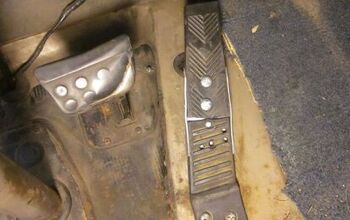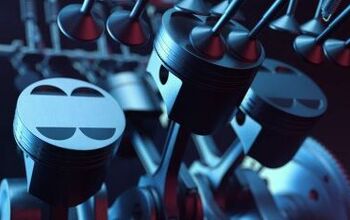Fixing A Hole
May’s new car sales numbers are in and things are looking bleak for The Big 2.8. Their corporate Spinmeisters can blame a down economy and sky-high gas prices all they like, but sales drops well into the double digits are never good news. Market share declines aren’t exactly glad tidings, either. That said, truth be told, Black Tuesday is actually a good sign. It shows that the domestic automakers have finally “accepted” the market. Whether they’re too late is another question entirely.
I repeat: the domestics’ massive sales drops are a good sign, not a good thing. The car market has been “overheated” for at least the last six years. Chrysler, Ford and GM have all been pushing easy credit, “Toe Tag Sales,” “employee pricing” and the like all year, every year. Compounding this "stack 'em high and sell 'em cheap" mentality, they dumped umpteen million extra vehicles onto fleets. “Move the metal” was their immutable mantra.
All this discounting “pulled forward” hundreds of thousands, even millions of sales. People used to buying a new car every five years were “trading up” after three. “Ten year” customers were buying in after five. Metal was moved but little or no profits were banked (all those discounts) and a lot of potential buyers were left completely “upside down” (all those fleet sales cratering resale value).
If The Big 2.8 were ever going to sell anything other than light trucks at a profit, they had to let the market “come up for air.” At the same time, they need time to re-tool to build more of the cars– yes, cars– people were bound– yes, bound– to want. And there’s another important reason why they had to ease off the throttle: financing.
Back when the U.S. auto industry was riding high, the domestics’ pet finance companies booked massive profits. Part of this was down to simple structure; a financing unit is little more than a bunch of computers, a phone center or two and a [relatively] small work force, most of whom make a lot less than assembly workers. With that kind of overhead, even fairly small margins can add up quickly. Given the sort of volume The 2.8 can move, those margins multiplied into the stratosphere.
Sinking sales means fewer loans. So The Big 2.8 bled the finance unit (easy terms and low rates) to prop-up manufacturing. It was an excellent strategy– for going broke twice as fast. Now that credit has been tightened (dodgy loans coming home to roost and all that), the finance arms can finally get on a firmer footing. In fact, sales and profits should return if not rise when the “fire-sale” customers’ cars wear out. This could take a couple of years and would seem to hurt the dealers– but not as much as you might think.
Dealers are conflicted. On one hand, they’re selling fewer cars. Generally speaking, they still make SOME profit, no matter what the discount. So volume is important. On the other hand, they are three to four months (minimum) behind the manufacturers curve on product lines. That’s a fancy way of saying they have a shit load of trucks and SUVs on their lots. Dealers need time to clear space and change their mix. But more importantly, they need to decide whether they want to stick it out at the reduced sales volumes.
For the manufacturers, toughing-out dealers is a major problem. Not because the dealers want to stay in business at any cost. Because they want the best pay-off to get out. The Big 2.8’s dealer deadwood are like holdout tenants in an apartment going condo (or UAW workers looking for a buyout). The longer they wait, they nastier it gets. But the longer they wait, the more they’ll get for leaving.
Bottom line: these sales drops are more of a symptom than a cause. The Big 2.8’s collective collapse is not causing them to finally face reality. The drop is the result of them finally facing reality and giving-up most of their number inflators.
Fifty years ago, GM had over 50 percent of the entire US market. As of May, the collective 2.8 don’t even hold that much. While that's still a huge slice of pie to bake (about 7.5m cars a year), it’s far below their production capacity. Until Detroit– and by that I mean their ops in Canada, Mexico, Australia, Belgium as well– get their production and model mix in line with the REAL market is (not where they’d like it to be), profits will be… elusive. Meanwhile, there's only one possible way for Detroit to recover market lost share: if and when one of them goes belly-up.
There is an oft-quoted British proverb: “if you find yourself in a hole, stop digging.” We can’t be sure if this is the bottom. As bad as it looks, at least the boys from Detroit have stopped digging– about two years late.
More by Andrew Dederer
Latest Car Reviews
Read moreLatest Product Reviews
Read moreRecent Comments
- Lorenzo The Renaissance Center was spearheaded by Henry Ford II to revitalize the Detroit waterfront. The round towers were a huge mistake, with inefficient floorplans. The space is largely unusable, and rental agents were having trouble renting it out.GM didn't know that, or do research, when they bought it. They just wanted to steal thunder from Ford by making it their new headquarters. Since they now own it, GM will need to tear down the "silver silos" as un-rentable, and take a financial bath.Somewhere, the ghost of Alfred P. Sloan is weeping.
- MrIcky I live in a desert- you can run sand in anything if you drop enough pressure. The bigger issue is cutting your sidewalls on sharp rocks. Im running 35x11.5r17 nittos, they're fine. I wouldn't mind trying the 255/85r17 Mickey Thompsons next time around, maybe the Toyo AT3s since they're 3peak. I like 'em skinny.
- Adam4562 I had summer tires once , I hit a pothole the wrong way and got a flat tire. Summer tires aren’t as durable as all season , especially up in the northeast . They are great of u live in Florida or down south . I have all season tires which are on my Subaru which is awd. My mom has a car so she switches from all season to snow tires . I guess depends on the situation
- MaintenanceCosts I hope they make it. The R1 series are a genuinely innovative, appealing product, and the smaller ones look that way too from the early information.
- MaintenanceCosts Me commenting on this topic would be exactly as well-informed as many of our overcaffeinated BEV comments, so I'll just sit here and watch.

































Comments
Join the conversation
garythepowers : June 5th, 2008 at 7:11 pm When I read the title of article I thought it was about a handyman who was a real jerk. Heh heh, Since the hard times hit me back in '86, that's been my survival strategy. Buy used or get free, repair, improvise, and make do. About the only thing I buy new is food.
"the beast defuncts being choken by higly organized quatropods and their unremmitting bites of quality, diversity and adaptation skills." That was beautiful, insightful.